Thanks OldSalt.
San Antonio, Then and Now (Image heavy)
172,748 Views |
466 Replies |
Last: 4 yr ago by Poot
dg77ag,
if you're still reading this thread I found something just now you might like regarding this info you posted:
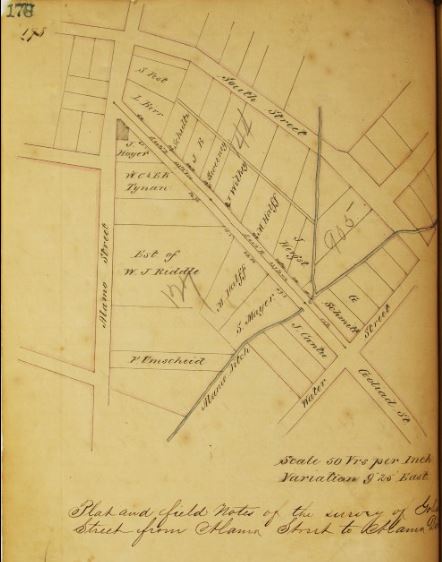
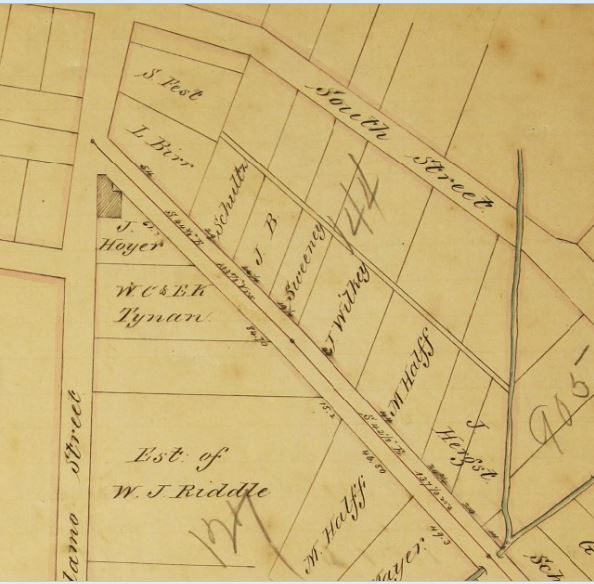
The City of San Antonio Official Digital Archives is pretty effin awesome. They've done a pretty great job digitizing a lot of their early records and has been a huge help in my research.
[This message has been edited by p_bubel (edited 10/30/2013 12:25p).]
if you're still reading this thread I found something just now you might like regarding this info you posted:
quote:
It's the James Sweeney House(117 Goliad St.) located next door to the Schultze house, this link below provides some more info which includes the address for the Schultze house as 115 Goliad St. My great grandfather Sweeney built the house for my grandparents.


The City of San Antonio Official Digital Archives is pretty effin awesome. They've done a pretty great job digitizing a lot of their early records and has been a huge help in my research.
[This message has been edited by p_bubel (edited 10/30/2013 12:25p).]
Great find p bubel! Yes, I enjoy reading this thread and seeing all the old pictures. I can't wait to search this site for other pertinent records. The plat you posted shows a estate of Wilson Riddle, in my own research I discovered he owned alot of real estate in this area, he previously owned the land the Sweeney house was built on, and it looks like my great-grandfather and his brother who were stonemasons and home builders bought the property across the street, something I believe the family is not aware of. Although we know they built other houses including the Sweeney house.
Unfortunately, on another note, in response to 04.arch.ag no one in the family has a useable photograph of the Sweeney house that would benefit him. However, it did provide an opportunity for three branches of Irish families to meet about a month ago and share pictures and stories. Your efforts with this thread have provided much fruit, thank you again.
Unfortunately, on another note, in response to 04.arch.ag no one in the family has a useable photograph of the Sweeney house that would benefit him. However, it did provide an opportunity for three branches of Irish families to meet about a month ago and share pictures and stories. Your efforts with this thread have provided much fruit, thank you again.
We have finished our portion of the condition assessment so some general maintenance and stabilization should be taking place on about 6 or 8 of the homes in hemisfair and likely a full restoration of 1 or 2.
Thanks 04.arch.ag, tried to pm you, the only picture we had was around the 1915 and family members obstructed views of the house. Looking forward to the renovation, it appears the first phase for the renovation of hemisfair will include this area.
http://www.expressnews.com/news/politics/article/Park-s-future-now-is-mapped-4921173.php
http://www.expressnews.com/news/politics/article/Park-s-future-now-is-mapped-4921173.php
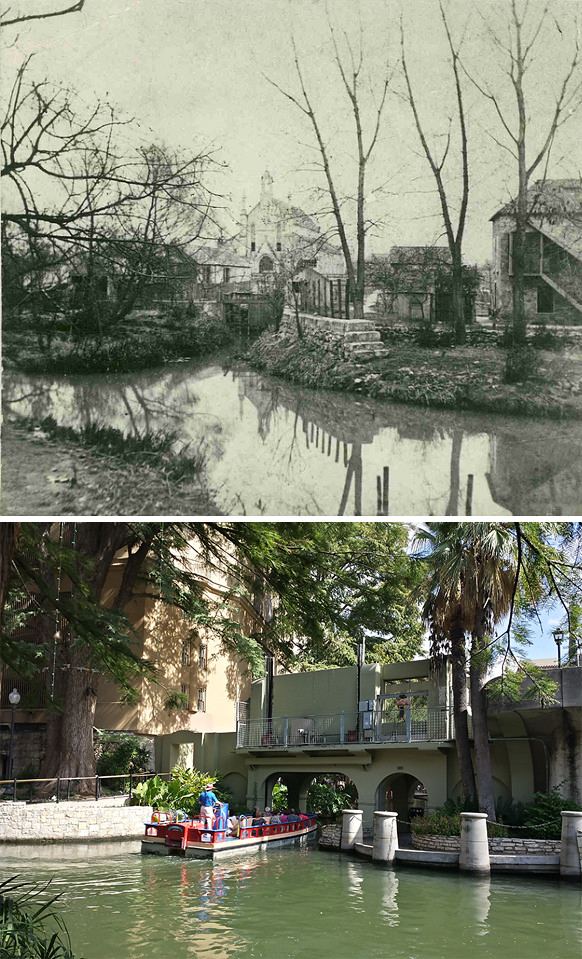
St Mary's Church, at the corner of College and St Mary's in the mid 1800s. The later floodgates were added after a series of disastrous floods in the early 20th centuries and were used to divert the flood waters away from the downtown bend in the river and down the contemporary flood channel. (Those same floods also spelled the end of the first version of St Mary's Church.)Those flood gates are seldom used today as a series of large tunnels now extend the length of the the downtown area and take the brunt of the flood waters. To the left of the photo is the "Ben Milam Cypress."
A history of the river:
www.edwardsaquifer.net/sariver.html
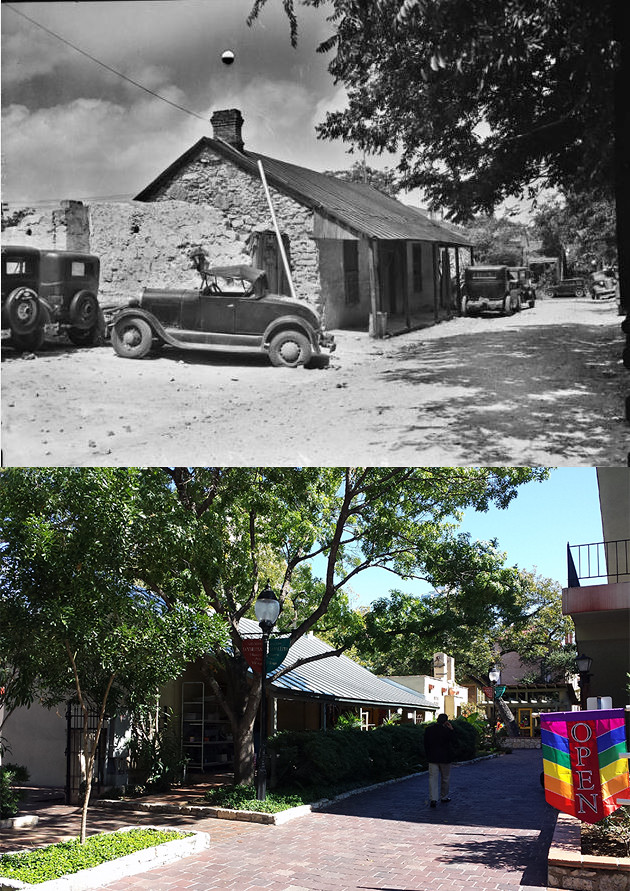
San Martin House in 1939
La Villita, in the heart of San Antonio, was once the site of a Coahuiltecan Indian village. The first huts in the community were probably erected about 1722. Families of soldiers attached to San Antonio de Béxar Presidio lived on the east side of the San Antonio River, which separated them after 1731 from the more aristocratic Canary Islanders. In 1773 the La Villita area was opened to refugees who moved to San Antonio from East Texas. Events of the Casas Revolt occurred in the little village. By 1819 a fairly exclusive residential area had grown up beside the humble homes of the soldiers. On December 10, 1835, Martín Perfecto de Cos capitulated to Texas soldiers at 515 Villita Street. John Coffee (Jack) Hays lived in the area in 1838. By the 1840s German immigrants had given a European flavor to the section; they were later joined by Swiss and French immigrants. The Indian, Spanish, Mexican, and Anglo colonial history of the section is preserved in the name of the streets and houses of La Villita: Guadalupe Street, Bolivar Hall, Juarez Plaza, Cos House, Canada House, and McAllister Corner.
http://maurymaverick.blogspot.com/2012/10/the-history-of-la-villita.html
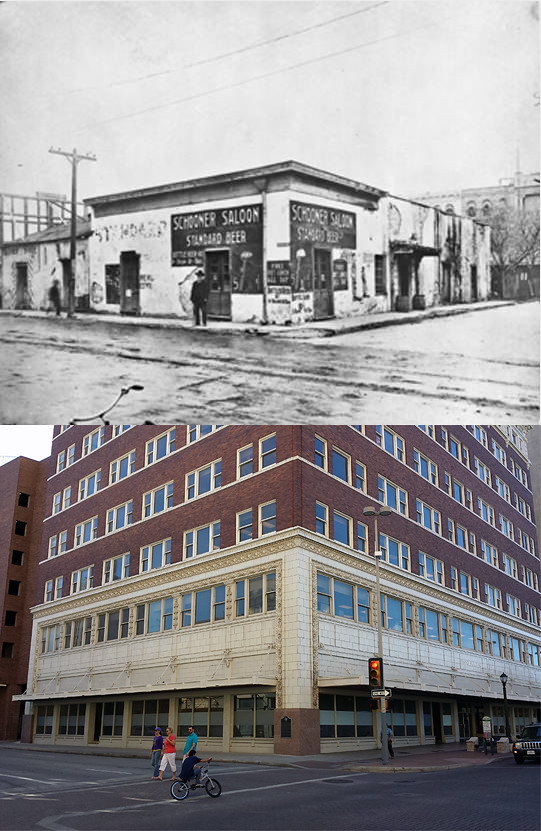
De la Garza House (1910)
The San Antonio Mint
Erected on this site in 1734 for prominent Bexar citizens Geronimo and Javiera Cantu de la Garza, the de la Garza family home was designed by Geronimo's brother-in-law Pedro Flores Valdez. The complex occupied an entire city block and was crafted with limestone and plaster walls three feet thick. Extensive gardens included cottonwood, pecan, fig and peach trees. The Spanish government granted the property to Javiera de la Garza in 1736 after her husband's death. Two generations later, Jose Antonio de la Garza used the home's vault to safeguard the valuables of local merchants. In 1818 the Spanish crown granted him permission to mint coins which became known as "jolas," a Spanish slang term for small currency of local issue used in the northeastern provinces of New Spain. The "jolas" replaced scarce Spanish silver in the value of a half "real," making the de la Garza home what was probably the first mint in Texas. During the Siege of Bexar in 1835, Ben Milam's troops engaged in a two-day battle to commandeer the fortress-like compound as their headquarters. Milam died in the struggle to take the city. After the siege possession of the home returned to the family, in whose control it remained for the rest of the century. Six months of demolition were required to bring down the de la Garza home in 1912. At that time a large sum of money was found hidden in the house and a sixteen-pound cannonball was discovered embedded in the walls, inscribing another page in the de la Garza chapter of San Antonio history.
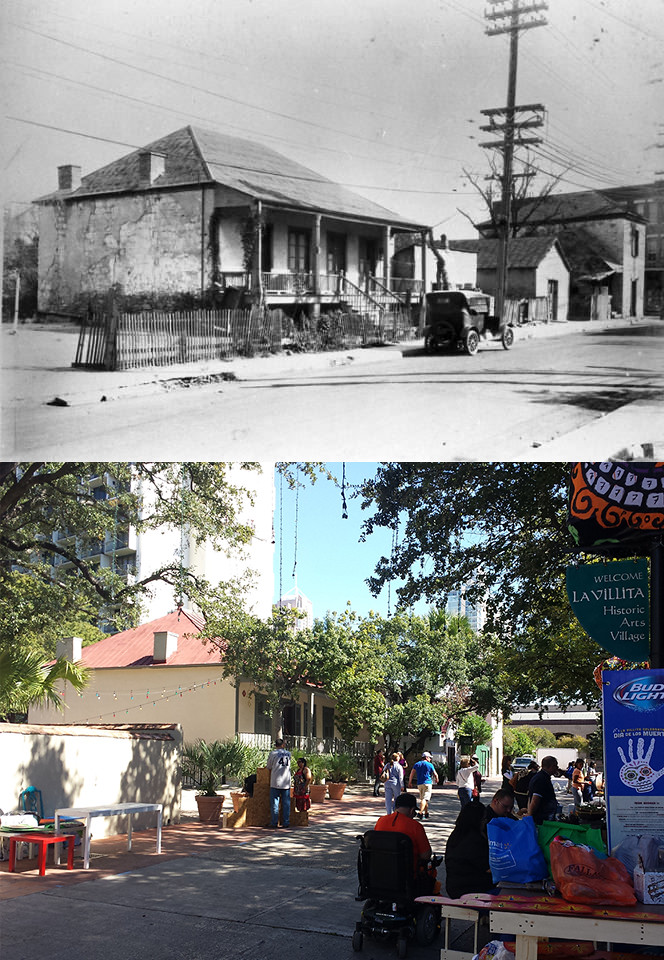
Dashiell House 1922 (La Villita)
Located on the banks of the San Antonio River in the La Villita Historic District, this one-story limestone house was built for Major Jeremiah Dashiell by San Antonio contractor and stonemason J.H. Kampmann, circa 1850. The San Antonio Conservation Society purchased the house in 1942, restored it, and used it as headquarters until 1975 when its offices moved to the Anton Wulff House.
More on La Villita here:
en.wikipedia.org/wiki/La_Villita

Alamo Street Looking north from Market in 1962. The structures in the foreground of the original photo were torn down to make way for a man made extension of the San Antonio Riverwalk that went east from the original bend in the river.
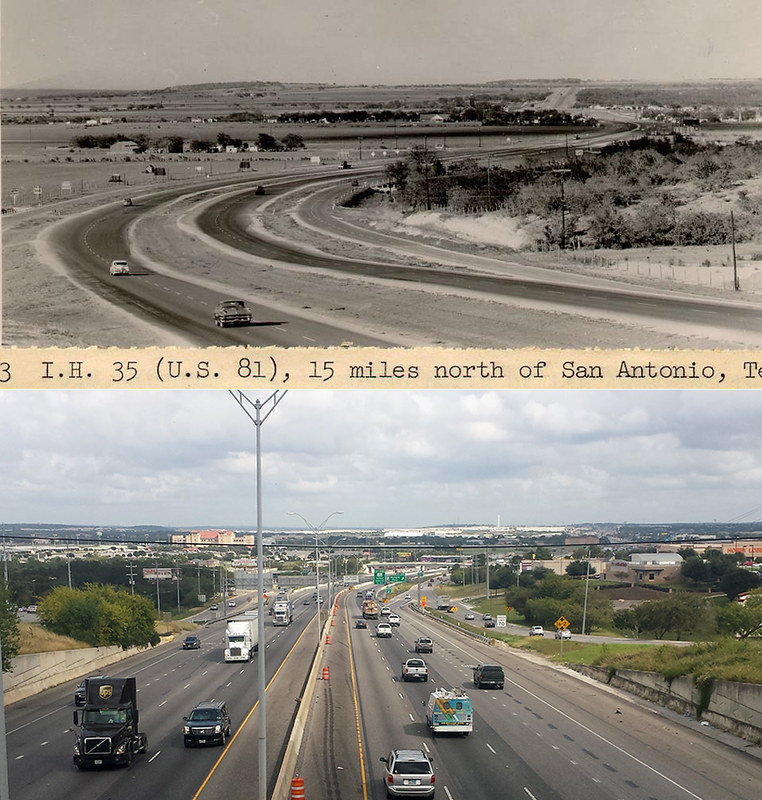
The new Interstate 35 at Selma, in the 1950s. Where the old Camino Real would cross Cibolo Creek.

Our Lady of Perpetual Help in Selma, Texas 1920.
(It's still there, just beyond Interstate 35, although in a modern form)
The village of Selma, Texas was established in 1847 by German immigrants at the Camino Real crossing at Cibolo Creek. By 1863 the village was already known as Selma. The people in the area were mostly Catholic families and their parish church was St. Peter and St. Paul in New Braunfels. In 1895, a group of 21 local families sought permission to erect a church of their own in order to avoid traveling from 11 to 20 miles by oxcart and buggies to New Braunfels.
The property on which the church was to be built came out of the Jacob Friesenhahn farm. Construction began on December 20, 1896, and was completed in February 1897. The formal dedication of Our Lady of Perpetual Help Church took place in July 1897 with Bishop Forest officiating.
A new red brick church with its tall bell tower overlooking the Cibolo Valley was dedicated in 1912. The old wooden church building was moved and converted into a two-room school. In 1918, tragedy struck when the beautiful red brick church was destroyed by fire. While cleaning out the burned church, a picture of Our Lady of Perpetual Help was found in the ashes. The frame had burned off and the picture was scarred and blistered, but not burned. Considering this a miracle, this picture has been highly honored by the parishioners throughout the years and hangs in the church today.
In 1941, a hurricane damaged the roof and destroyed the beautiful pipe organ. Insurance money was received, but it was used to pay church debts. The pipe organ was never replaced. In June 1943, Rev. Joseph H. Hildebrand was appointed pastor. His immediate goal was to pay off the debt still owed on the rebuilding of the church. By the late 1940’s the parish was changing from a farming and rural parish to a metropolitan one. Parish life and activities reflected a more urban approach.
In 1961, plans were announced to build a new church. The statues, Stations of the Cross, and the Crucifix were moved from the old church to the new one. The Statue of the Blessed Mother from the top of the steeple of the old church was placed over the front entrance of the new church. The dedication was May 20, 1962. This building and the rectory were demolished in 2006 as part of the latest building project. Because of the tremendous suburban growth, a decision was made to build a larger church—our present church. Archbishop Patrick Flores, along with Rev. Patrick Cronin, under whose visionary leadership the new church took shape, presided over the groundbreaking on May 25, 1986. The new church was dedicated on March 29, 1987.
Got 15 for y'all today. ****, I need to get a life.
[This message has been edited by p_bubel (edited 11/8/2013 1:40p).]
[This message has been edited by p_bubel (edited 11/8/2013 1:40p).]

Witte Building and Riverwalk in 1938
The Witte Museum traces its history to the death of a local businessman. On Sept. 22, 1925, construction began on a museum in San Pedro Park with $25,000 in city-approved funds. Alfred G. Witte died two days later. Construction halted shortly after when his will surfaced. Witte had bequeathed $65,000 for a museum of art, science and natural history to be built in Brackenridge Park and named after his parents.
Workers shifted building materials to the current site. Architect Robert Ayres added two new wings in an enlarged design, and construction commenced. The Witte opened on Oct. 8, 1926 to excited patrons and favorable press.
His store location still stands as one of the last 19th century ornate store fronts left on Commerce St.
[This message has been edited by p_bubel (edited 11/8/2013 2:10p).]

Houston St looking east at Soledad in 1890.

St Mary's Church in 1870.
In 1852, the Rt. Rev. J. M. Odin, first bishop of Galveston, realizing the need for a second parish church for the many non-Spanish speaking Catholics of the city, purchased the land where St. Mary's Chuch now stands. This was part of a Spanish land grant originally given by Ambrosio Rodriguez. That same year the Bishop invited the Brothers of Mary from France to open a boy's school on the property to the east of the church. The permanent building that was finally erected became St. Mary's Academy and was the forerunner of the Central Catholic High School and St. Mary's University. In the 1960's when the Brothers of Mary sold the property for the building of the La Mansion Hotel, the facade of a modified version of it was used for the Hotel.
For the building of the new church, Rev. J. M. Dubuis, rector of San Fernando, collected $10,214.50 in San Antonio and more in Galveston and New Orleans. He broke ground in the autumn 1855 and laid the cornerstone in 1856. Services began early in 1857. Named St. Mary's, the church was dedicated to the Immaculate Conception. Father Dubuis served as Pastor of San Fernando and St. Mary's. There were two Sunday Masses, one for the English speaking and one for the Germans, until the latter built St. Joseph's Church.
In 1921, a disastrous flood devastated downtown San Antonio including St. Mary's Church; and it was decided to build a new one. The last service in the old structure was held May, 1923. The new cornerstone was laid in January, 1924; and the building finished in August of the same year. The church, modified Romanesque designed by architect F.B. Gaenslen, was modeled after Sacred Heart Church in Lowell Massachusetts.

St Mark's Episcopal in 1877.
The end of the Mexican War in 1848 opened the floodgates of growth and prosperity in the new state of Texas. San Antonio, on the western edge of the frontier, was particularly awash in new development. Waves of immigrants from the rest of the United States and from Europe sent the old Spanish town’s population soaring beyond 8,000
The nation’s leading church architect, Richard Upjohn, designer of Trinity Church at the head of Wall Street in New York, was hired to design a building for St. Mark’s, one of his few commissions west of the Mississippi. But even as civilian members were aided by Episcopalians stationed in San Antonio as U.S. Army officers most prominent among them Robert E. Lee, in 1860 a lieutenant colonel in temporary command of the Department of Texas — sufficient funds could not be raised to complete the building before the Civil War broke out. Services had to continue being held in rented rooms
Work on Upjohn’s unfinished church did not resume until after the arrival in 1868 of the fifth rector, Walter Raleigh Richardson, 31. As the region recovered from the war, construction resumed in 1873 and the Gothic style limestone block building was completed and dedicated on Easter Sunday 1875. The church bell was cast from a bronze cannon found buried near the Alamo on the grounds of the home of founding members Samuel and Mary A. Maverick.

San Antonio River looking south at Market St (1927-31)
To the left is now the Hilton Palacio del Rio, and will be the subject of another photo. ( It was built for Hemisfare in record time due to the module type construction that was developed specifically for this building)

San Antonio River (1927-31) with the Ben Milam Tree and Twohig Home.

Alamo Street looking south in 1910 (taken from Alamo Plaza)

Duerler Confectionary in 1880. In the foreground and in the top hat there is someone selling early photographs along commerce street.
Born in St. Gallen, Switzerland, in 1841, Gustav Anton Duerler’s family immigrated to Texas in the 1849, settling in San Antonio, Texas. He was apprenticed in a printer’s office at an early age and worked in that field and in clerical positions before serving in the Confederate army for three years. After the Civil War, he returned to San Antonio where he established and developed a confectionery that eventually grew into the Duerler Manufacturing Company.
Half and Brother wholesale dry goods to the right of the Duerler building.

Moving Alamo National Bank in 1912.
Street widening was prolific downtown in the early part of the 20th century. Most buildings either had their facades removed a few feet back (Dulning Building) or fell to the wrecking ball altogether (the Veramendi Palace)
The Alamo National Bank took the novel approach to the problem by sliding the building back nearly 17 feet. It took 40 men with screw jacks and metal rollers several days to complete the work all the while the bank remained open for business.

The San Antonio River at Mill Bridge (now Navarro) looking at La Villia. (1870) there's a "bathing cart" in the right foreground in the original photo.

Laux Mill in the 1880s from Houston St
Laux moved to San Antonio in 1859 and constructed
the first flour mill in the City. All other mills, at that
time, were grist mills.

Alamo Drug Store in 1880, Adolph Dreiss Owner.
In 1849, the Dreiss family with son Adolph, 7, came to New Orleans first by ship, then went on to Indianola, and finally to New Braunfels by oxcart. In 1852, Heinrich bought a 60-acre farm from an orphanage worth $600 for only $25 cash. He built a cabin and bought a cow and a yoke of oxen. Adolph went to school in town and his father sent a pot of butter to pay for his room and board.
“My great-great grandfather (Heinrich Albert) and grandfather (James Edward) started the San Antonio drug company which was in the Alamo Plaza, right across from the Alamo and the Menger Hotel,” F.G. said. “The name, ‘Dreiss-Thompson’, is still on the back of the building which faces the San Antonio River. My dad was born in the upstairs of the building.”
At some point the front facade was removed and this plain brick building is all that stands on the spot. The rear, however, still has the Dreiss family name and ornamentation.

[This message has been edited by p_bubel (edited 11/8/2013 1:49p).]

Soutside Food Store (620 Labor St)

S Presa at Carolina in the 1940s

The north side of Military Plaza.
Not quite from the same angle, but you have to work with what you're given.
p_bubel- any chance you've run across pictures of the old McKinley Ave UMC on South Presa? Would love to get some old pictures of that old building.
Thanks for all the work you've done. makes us nerds very happy.
Thanks for all the work you've done. makes us nerds very happy.
I'll take a look around when I get back from College Station on Sunday and see what I have.
Thanks. I've tried and been unsuccessful so far.
Sorry Mike, I have not been able to find anything.
I'll keep an eye out though.
I'll keep an eye out though.
Featured Stories
See All
9:33
16h ago
4.3k
Aggies run-rule Purdue as 'Lefty' keeps no-no on scorekeeping oddity
by Kolton Becker
5 Thoughts: No. 10 Texas A&M 67, No. 15 Missouri 64
by Luke Evangelist
5:17
13h ago
1.1k
